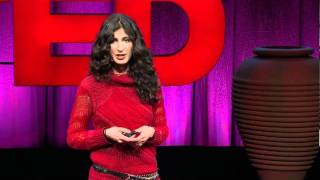(单词翻译:单击)
Good morning everybody. I work with really amazing, little, itty-bitty creatures called cells.
大家早上好。我的工作是关于非常惊人的微小生物,它们叫做细胞。
And let me tell you what it's like to grow these cells in the lab.
让我告诉你们如何在实验室里培养这些细胞。
I work in a lab where we take cells out of their native environment.
在实验室中,我们将细胞从它们的原生环境取出。
We plate them into dishes that we sometimes call petri dishes.
我们将它们放置到碟子中,有时我们称这些碟子为培养皿。
And we feed them -- sterilely of course -- with what we call cell culture media
我们当然是用无菌的方式喂食这些细胞,用的是称为细胞培养基的东西,
which is like their food -- and we grow them in incubators.
这就如同它们的食物,然后我们在培养器中培养它们。
Why do I do this? We observe the cells in a plate, and they're just on the surface.
为什么我要这么做? 我们观察培养皿中的细胞,它们都分布在培养基的表面。
But what we're really trying to do in my lab is to engineer tissues out of them.
但我们在实验室里想做的是利用它们做出组织。
What does that even mean? Well it means growing an actual heart, let's say, or grow a piece of bone that can be put into the body.
而这到底是什么意思呢? 意思是培养一颗真的心脏,又例如培养一块骨头,能放到身体里面的骨头。
Not only that, but they can also be used for disease models.
不但如此,它们也能用于疾病模型。
And for this purpose, traditional cell culture techniques just really aren't enough.
但如果要这么做,传统的细胞培养技术就略显不足了。
The cells are kind of homesick; the dish doesn't feel like their home.
这些细胞有点适应不良,培养皿一点都不像它们生长的地方。
And so we need to do better at copying their natural environment to get them to thrive.
因此我们需要在复制它们的自然环境方面加强,才能使它们成长茁壮。
We call this the biomimetic paradigm -- copying nature in the lab.
我们称这个技术为“仿生范式”,也就是在实验室中复制自然环境。
Let's take the example of the heart, the topic of a lot of my research.
我们拿心脏来当例子好了,这是我研究很多的主题。
What makes the heart unique? Well, the heart beats, rhythmically, tirelessly, faithfully.
心脏独特之处在那里? 心脏会跳动,很规律、很不倦地、忠诚地跳动。
We copy this in the lab by outfitting cell culture systems with electrodes.
我们在实验室里复制心跳,方法是在细胞培养系统加入电极。
These electrodes act like mini pacemakers to get the cells to contract in the lab.
这些电极功能就像迷你心律调整器,能够让细胞在实验室里收缩。
What else do we know about the heart? Well, heart cells are pretty greedy.
此外,我们对心脏还知道些什么? 心脏细胞是非常耗能的。
Nature feeds the heart cells in your body with a very, very dense blood supply.
大自然必须用很充沛的血液量来维持体内的心脏细胞的运作。

In the lab, we micro-pattern channels in the biomaterials on which we grow the cells,
在实验室里,我们用生物材料制作微小的管道,然后我们在那上面培养细胞,
and this allows us to flow the cell culture media, the cells' food, through the scaffolds where we're growing the cells
这样我们才能将细胞培养基,也就是细胞的食物,注入我们培养细胞的支架,
a lot like what you might expect from a capillary bed in the heart.
很像我们印象中的心脏微血管床。
So this brings me to lesson number one: life can do a lot with very little.
这样我们就可以开始进入主题了: 生命即使在匮乏的环境中也能成就非凡。
Let's take the example of electrical stimulation. Let's see how powerful just one of these essentials can be.
我们用电刺激来举个例子好了。我们来看看这个要素本身的功能有多强大。
On the left, we see a tiny piece of beating heart tissue that I engineered from rat cells in the lab.
在左边,我们可以看见一小块在跳动的心脏组织,这是我在实验室中从老鼠细胞做出来的。
It's about the size of a mini marshmallow. And after one week, it's beating.
它跟迷你棉花糖一样大。一个礼拜后,它开始跳动了。
You can see it in the upper left-hand corner. But don't worry if you can't see it so well.
你可以在左上角的图中看到。如果你看不清楚也不用担心。
It's amazing that these cells beat at all.
这些细胞光是会跳动就很令人惊奇了。
But what's really amazing is that the cells, when we electrically stimulate them, like with a pacemaker, that they beat so much more.
但是真正令人惊讶的是,当我们用电刺激这些细胞时,就像用一个心律调整器一样,这些细胞跳得更有生命力了。
But that brings me to lesson number two: cells do all the work.
再来我要讲第二课了: 所有的工作交给细胞就好了。
In a sense, tissue engineers have a bit of an identity crisis here,
就某方面来说,组织工程师有一点身份认同的危机,
because structural engineers build bridges and big things, computer engineers, computers,
因为结构工程师建造桥梁及巨大的物体,计算机工程师当然就是计算机了,
but what we are doing is actually building enabling technologies for the cells themselves.
但我们所从事的工作,其实是建造一个科技来启动细胞本身。
What does this mean for us? Let's do something really simple.
这对我们来说代表着什么呢?我们来做一件简单的事。
Let's remind ourselves that cells are not an abstract concept.
我们来提醒自己细胞并不是一个抽象的概念。
Let's remember that our cells sustain our lives in a very real way.
我们要记得,细胞维持着我们的生命,用的是非常真实的方式。
"We are what we eat," could easily be described as, "We are what our cells eat."
“我们吃什么就像什么”可以简单得说成“细胞吃什么,我们就像什么”。
And in the case of the flora in our gut, these cells may not even be human.
例如我们肠道内的菌群,这些细胞甚至不是人体的。
But it's also worth noting that cells also mediate our experience of life.
但值得注意的是,细胞还调节着我们对人生的体验。
Behind every sound, sight, touch, taste and smell is a corresponding set of cells that receive this information and interpret it for us.
在听觉、视觉、触觉、味觉、嗅觉的背后,各有一组对应的细胞来接受信息,并为我们诠释。
It begs the question: shall we expand our sense of environmental stewardship to include the ecosystem of our own bodies?
这就引出一个问题:我们是否应该把环境管理意识概念扩展到我们身体的生态环境?
I invite you to talk about this with me further, and in the meantime, I wish you luck.
我欢迎你们和我更进一步的探讨这个话题,而与此同时,我要祝大家好运。
May none of your non-cancer cells become endangered species. Thank you.
希望大家的非癌细胞都不会变成稀有物种。谢谢大家。


